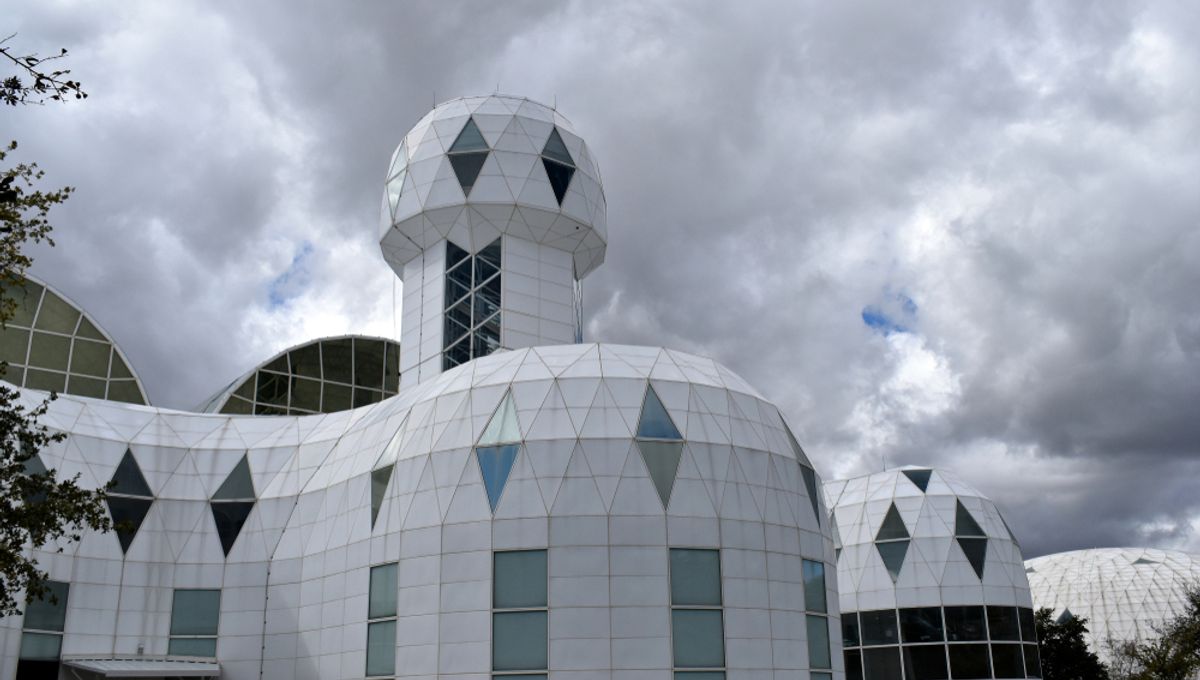
If we’re ever to survive on other planets, we’re going to need to come up with effective and sustainable ways of not becoming dead. This means growing food, having water and oxygen, and all the other stuff we have on Earth that prevents us from being a corpse.
Short of terraforming a whole planet, we’re left with creating our own artificial biospheres for space-faring humans to inhabit – enclosed ecosystems with their own oxygen, plants, and everything we need to sustain life. Ambitious trials of this have taken place on Earth, including the infamous Biosphere 2.
Costing between $150-200 million, Biosphere 2 (Biosphere 1 is Earth by the way, in case you’re wondering) is a research facility out in the desert that – for a time – aimed to be such an enclosed ecosystem, recreating many aspects of Earth itself. Inside the 2.75 acre complex, enclosed in steel and glass like the dome from The Simpsons Movie, 3,800 species of plants and animals were shut in with eight humans (four women and four men) who would be relying on the food grown and oxygen circulated to survive.
The plan was for the project to last two years, but hit trouble from the beginning.
Two weeks into the mission, one of the occupants, Jane Poynter, got her hand caught in the rice thresher, losing the tip of one of her fingers. The resident doctor was able to reattach it, but soon decided she needed surgery outside of the dome. When she returned later that day, supplies were snuck in with her, which turned out to not be the only secret stocks that the “Biospherians” would dip into.
Food inside the sphere did not grow quickly enough to sustain the residents, and they all began to lose weight. The crops were too slow-growing and labor-intensive. The coffee bushes, for instance, took weeks to make enough for a single cup for the Biospherians to sit down with and mull over the “we have no other food either” problem. Within months, they were forced to break into emergency supplies of food that the outside world was unaware of.
The pollinators – hummingbirds and honeybees – died off, adding to their farming troubles. 10 months into the project, the advisory board issued a damning report of the situation, as well as the fact that the crew members involved had little scientific expertise. The advisory board then all quit, which is never a great sign that things are going splendidly.
Worse was still to come, as oxygen levels within the biosphere began to drop, and nobody at the time could figure out precisely why. In January 1993, with nine months of the experiment still left, oxygen levels had dropped to around 15 percent – the equivalent of living 12,000 feet (3660 meters) up a mountain.
“It felt like mountain-climbing,” one participant told the Guardian. “Some of the crew started getting sleep apnoea. I noticed I couldn’t finish a long sentence without stopping and taking a breath of air. We worked in a kind of slow-motion dance, with no energy wasted. If the oxygen levels had dropped any lower, there could have been serious health issues.”
To add to their stress, the biosphere became a tourist destination in order to recoup the high cost involved. As they starved, and struggled to breathe, cockroaches began to take over, and mites attacked their crops, they were being watched like they were in a zoo.
The group became fractured, throwing cups and spitting at each other. With morale as low as the oxygen levels (mainly the latter), it was decided that the crew should be given food, as well as the secret seeds and vitamins that were being snuck into the complex every fortnight.
Half of the crew wanted to continue without outside supplies, while the other half were keen on things such as “food” and “being able to breathe”. It was decided that oxygen and food should be supplied to the crew, who lived out the rest of the time in their cut-off sustainable habitat by… receiving supplies and breathable air from Earth.
The biggest takeaway from the project was essentially to expect the unexpected. When they went in, the team hadn’t anticipated problems such as drops in oxygen (it transpired that the soil had been infested with oxygen-gulping bacteria), perhaps because the whole project was started by a hippie theater troupe rather than scientists.
The project wasn’t quite over, however, with a weird twist still to come. Steve Bannon (yes, that Steve Bannon) took over the running of the project in 1993. A second crew had already entered the dome when Bannon fired the whole of the leadership.
When members of the first mission heard about this, their concerns about the safety of those inside grew. On April 4, 1994, two former Biospherians – Abigail Alling and Mark Van –- headed down to the dome in the early hours of the morning, opening doors and smashing glass panels to allow outside air to flood into Biosphere 2, forcing the experiment to end.
Since then, nobody has lived in Biosphere 2. Which, given the lack of oxygen and food in there, is probably a good thing.
An earlier version of this article was published in March 2021.
Source Link: Eight People Attempted To Live In A Biosphere For Two Years – Then It All Went Terribly Wrong